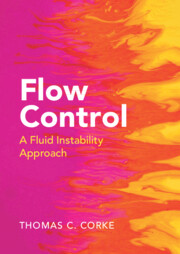Book contents
- Frontmatter
- Dedication
- Contents
- Preface
- 1 Introduction
- 2 Sensors and Actuators
- 3 Bluff Body Wakes
- 4 Separated Flows
- 5 Free Shear Layers and Jets
- 6 Two-Dimensional Laminar Boundary Layers
- 7 Three-Dimensional Laminar Boundary Layers
- 8 Turbulent Boundary Layers
- 9 Shock–Boundary-Layer Interaction
- 10 Flow Control by Design
- References
- Index
9 - Shock–Boundary-Layer Interaction
Published online by Cambridge University Press: 04 April 2024
- Frontmatter
- Dedication
- Contents
- Preface
- 1 Introduction
- 2 Sensors and Actuators
- 3 Bluff Body Wakes
- 4 Separated Flows
- 5 Free Shear Layers and Jets
- 6 Two-Dimensional Laminar Boundary Layers
- 7 Three-Dimensional Laminar Boundary Layers
- 8 Turbulent Boundary Layers
- 9 Shock–Boundary-Layer Interaction
- 10 Flow Control by Design
- References
- Index
Summary
Chapter 9 involves shock–boundary-layer interactions that are intrinsic to supersonic engine intakes, transonic gas turbine blade tip gaps and blade passages, scramjet isolator ducts, transonic and supersonic flight vehicle surfaces, and surfaces of rockets, missiles, and reentry vehicles. It is of particular interest because it can result in large temporal and spatial pressure variations, and greatly affect boundary development including causing flow separation that feeds into the flow unsteadiness, and subsequently has a large impact on aerodynamic performance. The outcome of shock–boundary-layer interactions strongly depends on steady and unsteady initial conditions that can be factored into flow control approaches. Methods for these are presented.
Keywords
Information
- Type
- Chapter
- Information
- Flow ControlA Fluid Instability Approach, pp. 377 - 407Publisher: Cambridge University PressPrint publication year: 2024
